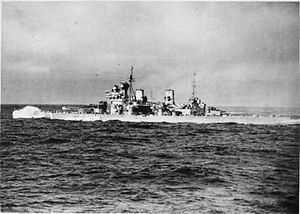George Creasy
Commander of the Legion of Merit (United States) |
|---|
Creasy served in the
After the war Creasy became Flag Officer (Air),
Early career
Born the son of Leonard Creasy and Maud Creasy (née Elvey), Creasy was educated at the Royal Naval College, Osborne and the Royal Naval College, Dartmouth.[1] He joined the Royal Navy as a cadet in September 1908 and was promoted to midshipman on his appointment to the battleship HMS Conqueror on 15 May 1913.[2]
First World War
Creasy served in the
Between the wars
Creasy successfully passed his exams at HMS Vernon and then became torpedo lieutenant in the destroyer
Creasey next became executive officer in the cruiser HMS Sussex, attached to the Royal Australian Navy, in July 1934 and, having been appointed a Member of the Royal Victorian Order on 21 November 1934,[8] and promoted to captain on 31 December 1935,[9] he became assistant director of plans at the Admiralty in June 1936.[2] He went on to be captain (destroyers) of the 1st Destroyer Flotilla in the Mediterranean Fleet and commanding officer of the destroyer HMS Grenville in May 1938.[2]
Second World War

Creasy served in the
Creasy was also appointed to the Polish
Promoted to

Later career
After the war Creasy was appointed Flag Officer (Air),
Creasey was advanced to Knight Grand Cross of the Order of the Bath on 1 June 1953[21] before becoming Commander-in-Chief, Portsmouth and NATO Allied Commander-in-Chief Channel Command in September 1954.[12] He was promoted to Admiral of the Fleet on 22 April 1955[22] and then retired in 1957.[5]
Retirement and family
In 1924 Creasy married Monica Frances Ullathorne; they had a daughter and a son.[1]
In retirement, Creasy became
References
- ^ required.)
- ^ a b c d e f g h i j k Heathcote, p. 55
- ^ "No. 29368". The London Gazette. 16 November 1915. p. 11323.
- ^ "No. 30551". The London Gazette. 1 March 1918. p. 2637.
- ^ a b "George Creasy". Liddell Hart Centre for Military Archives. Retrieved 17 August 2014.
- ^ "No. 33003". The London Gazette. 19 December 1924. p. 9244.
- ^ "No. 33621". The London Gazette. 1 July 1930. p. 4109.
- ^ "No. 34147". The London Gazette. 2 April 1935. p. 2230.
- ^ "No. 34238". The London Gazette (Supplement). 31 December 1935. p. 15.
- ^ "No. 34893". The London Gazette (Supplement). 9 July 1940. p. 4257.
- ^ "No. 35554". The London Gazette (Supplement). 8 May 1942. p. 2066.
- ^ a b c d e f g h Heathcote, p. 56
- ^ "No. 35833". The London Gazette (Supplement). 18 December 1942. p. 5569.
- ^ "No. 35841". The London Gazette (Supplement). 29 December 1942. p. 7.
- ^ "No. 36096". The London Gazette. 16 July 1943. p. 3232.
- ^ "No. 36624". The London Gazette (Supplement). 21 July 1944. p. 3461.
- ^ "No. 37582". The London Gazette (Supplement). 24 May 1946. p. 2559.
- ^ "No. 38189". The London Gazette. 27 January 1948. p. 662.
- ^ "No. 38493". The London Gazette (Supplement). 31 December 1948. p. 2.
- ^ "No. 39136". The London Gazette (Supplement). 30 January 1951. p. 548.
- ^ "No. 39863". The London Gazette (Supplement). 26 May 1953. p. 2942.
- ^ "No. 40487". The London Gazette. 24 May 1955. p. 3011.
- ^ "No. 41645". The London Gazette. 27 February 1959. p. 1400.
Sources
- Heathcote, Tony (2002). The British Admirals of the Fleet 1734 – 1995. Pen & Sword Ltd. ISBN 0-85052-835-6.
External links
- "Obituary: Admiral of the Fleet Sir George Creasy". The Times. November 1972. Retrieved 17 August 2014.
